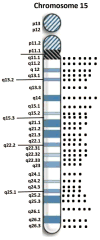Prader-Willi syndrome genetic subtypes and clinical neuropsychiatric diagnoses in residential care adults
- PMID: 28984907
- PMCID: PMC5828945
- DOI: 10.1111/cge.13142
Prader-Willi syndrome genetic subtypes and clinical neuropsychiatric diagnoses in residential care adults
Abstract
The historical diagnosis of Prader-Willi syndrome (PWS), a complex genetic disorder, in adults is often achieved by clinical presentation rather than by genetic testing and thus limited genetic subtype-specific psychometric investigations and treatment options. Genetic testing and clinical psychiatric evaluation using Diagnostic and Statistical Manual (DSM)-IV-TR criteria were undertaken on 72 adult residents (34 M; 38 F) from the Prader-Willi Homes of Oconomowoc (PWHO), a specialty PWS group home system. Methylation specific-multiplex ligation probe amplification and high-resolution microarrays were analyzed for methylation status, 15q11-q13 deletions and maternal uniparental disomy 15 (mUPD15). Seventy (33M; 37F) of 72 residents were genetically confirmed and 36 (51%) had Type I or Type II deletions; 29 (42%) with mUPD15 and 5 (7%) with imprinting defects from three separate families. Psychiatric comorbidities were classified as anxiety disorder (38%), excoriation (skin picking) (33%), intermittent explosive disorder ([30%-predominantly among males at 45% compared with females at 16% [OR = 4.3, 95%CI 1.4-13.1, P < 0.008]) and psychotic features (23%). Psychiatric diagnoses did not differ between mUPD15 vs deletion, but a greater number of psychiatric diagnoses were observed for the larger Type I (4.3) vs smaller Type II (3.6) deletions when age was controlled (F = 5.0, P < 0.04). Adults with PWS presented with uniformly higher rates of psychiatric comorbidities which differed by genetic subtype with gender-specific trends.
Keywords: PWS genetic subtypes; Prader-Willi syndrome (PWS); neuropsychiatric diagnoses; residential care adults.
© 2017 John Wiley & Sons A/S. Published by John Wiley & Sons Ltd.
Conflict of interest statement
There are no conflicts of interest to report for any of the authors.
Figures






Similar articles
-
Molecular genetic classification in Prader-Willi syndrome: a multisite cohort study.J Med Genet. 2019 Mar;56(3):149-153. doi: 10.1136/jmedgenet-2018-105301. Epub 2018 May 5. J Med Genet. 2019. PMID: 29730598 Free PMC article.
-
Genotype-phenotype characteristics of 57 patients with Prader-Willi syndrome: a single-center experience from Turkey.Clin Dysmorphol. 2024 Oct 1;33(4):145-151. doi: 10.1097/MCD.0000000000000506. Epub 2024 Jun 18. Clin Dysmorphol. 2024. PMID: 38934057
-
Mosaicism for maternal uniparental disomy 15 in a boy with some clinical features of Prader-Willi syndrome.Eur J Med Genet. 2014 May-Jun;57(6):279-83. doi: 10.1016/j.ejmg.2014.03.007. Epub 2014 Apr 2. Eur J Med Genet. 2014. PMID: 24704109
-
Prader-Willi syndrome: clinical genetics, cytogenetics and molecular biology.Expert Rev Mol Med. 2005 Jul 25;7(14):1-20. doi: 10.1017/S1462399405009531. Expert Rev Mol Med. 2005. PMID: 16038620 Free PMC article. Review.
-
Prader-Willi Syndrome - Clinical Genetics, Diagnosis and Treatment Approaches: An Update.Curr Pediatr Rev. 2019;15(4):207-244. doi: 10.2174/1573396315666190716120925. Curr Pediatr Rev. 2019. PMID: 31333129 Free PMC article. Review.
Cited by
-
Genetic Subtype-Phenotype Analysis of Growth Hormone Treatment on Psychiatric Behavior in Prader-Willi Syndrome.Genes (Basel). 2020 Oct 23;11(11):1250. doi: 10.3390/genes11111250. Genes (Basel). 2020. PMID: 33114160 Free PMC article.
-
Variant pubertal development in Prader-Willi syndrome: early and slow progression of pubarche with normal age at gonadarche.Front Endocrinol (Lausanne). 2025 Apr 15;16:1527140. doi: 10.3389/fendo.2025.1527140. eCollection 2025. Front Endocrinol (Lausanne). 2025. PMID: 40303632 Free PMC article.
-
Multidimensional Evaluation of Awareness in Prader-Willi Syndrome.J Clin Med. 2021 May 7;10(9):2007. doi: 10.3390/jcm10092007. J Clin Med. 2021. PMID: 34067179 Free PMC article.
-
Endocrine features of Prader-Willi syndrome: a narrative review focusing on genotype-phenotype correlation.Front Endocrinol (Lausanne). 2024 Apr 26;15:1382583. doi: 10.3389/fendo.2024.1382583. eCollection 2024. Front Endocrinol (Lausanne). 2024. PMID: 38737552 Free PMC article. Review.
-
Psychotic illness in people with Prader-Willi syndrome: a systematic review of clinical presentation, course and phenomenology.Orphanet J Rare Dis. 2024 Feb 15;19(1):69. doi: 10.1186/s13023-024-03026-y. Orphanet J Rare Dis. 2024. PMID: 38360662 Free PMC article.
References
-
- Butler JV, Whittington JE, Holland AJ, Boer H, Clarke D, Webb T. Prevalence of, and risk factors for, physical ill-health in people with Prader-Willi syndrome: a population-based study. Dev Med Child Neurol. 2002;44(4):248–255. - PubMed
-
- Cassidy SB, Schwartz S, Miller JL, Driscoll DJ. Prader-Willi syndrome. Genet Med. 2012;14(1):10–26. - PubMed
Publication types
MeSH terms
Grants and funding
LinkOut - more resources
Full Text Sources
Other Literature Sources
Medical

